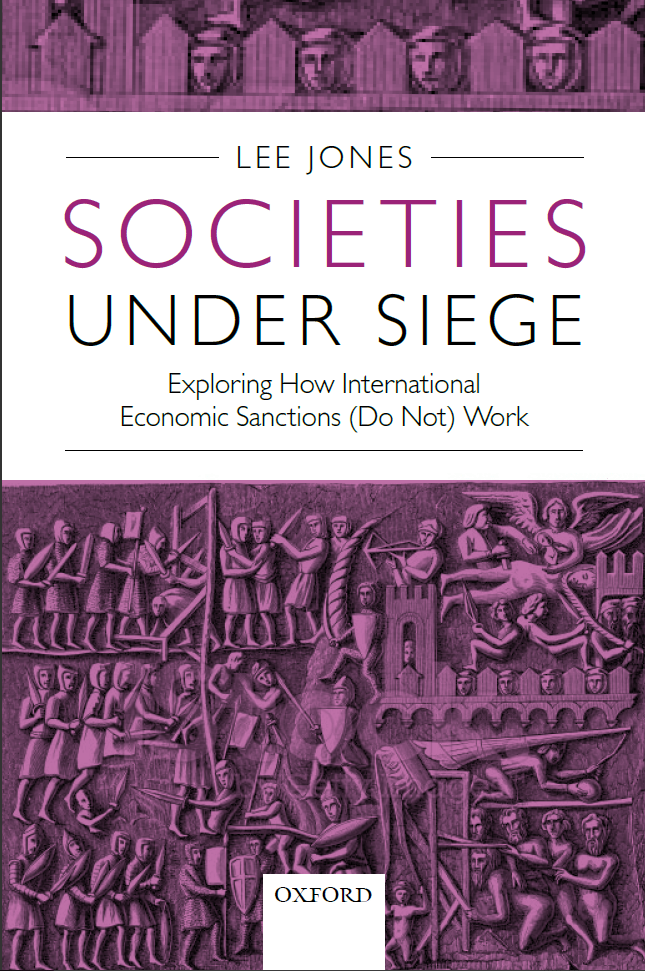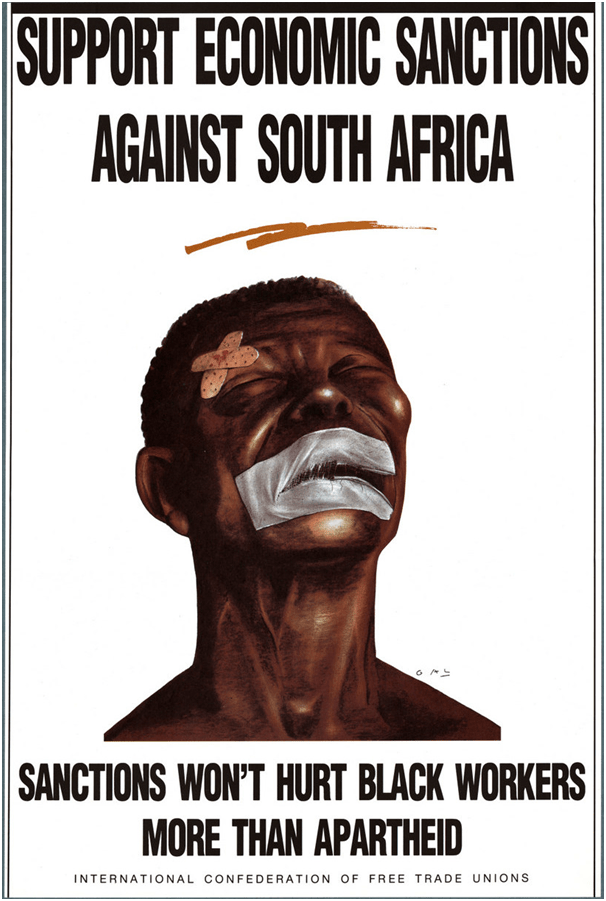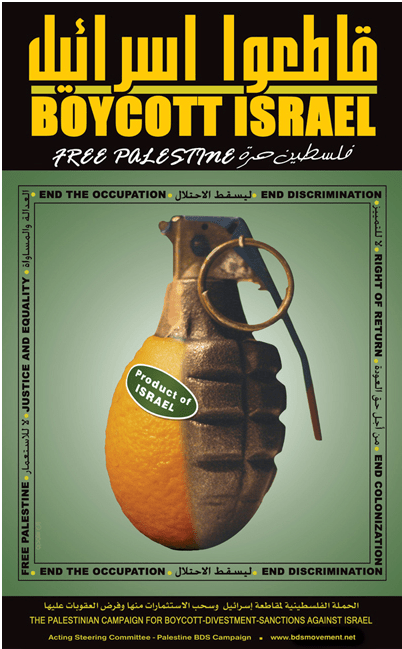This is the first in a series of posts on Lee Jones’ Societies Under Siege: Exploring How International Economic Sanctions (Do Not) Work. Responses will follow from guest authors Elin Hellquist, Clara Portela and Katie Attwell over the next few days.
It doesn’t seem to matter what the international crisis is: be it an inter-state war (Russia-Ukraine), civil strife (Syria), gross violations of human rights (Israel), or violent non-state actors on the rampage (ISIS, al-Qaeda), the ‘answer’ from governments and civil society always seems to be the same: impose economic sanctions. In the mid-20th century, only five countries were targeted by sanctions; by 2000, the number had increased tenfold. Once an obscure, rarely used and widely dismissed form of statecraft, sanctions are now clearly central to the exercise of power in international relations – particularly when dominant powers are reluctant to put ‘boots on the ground’.
My new book, Societies Under Siege: Exploring How International Economic Sanctions (Do Not) Work, is the first comparative effort to explore how these sanctions ‘work’ in practice – on the ground, in target states. This post introduces the book and the forum that will follow.

Societies Under Siege cover. The image is an engraving of a (failed) siege during the Albigensian crusade.
I first became interested in sanctions through my research on Myanmar (Burma) for my first book, ASEAN, Sovereignty and Intervention in Southeast Asia. In Myanmar, sanctions seemed to have minimal effect, yet they were constantly being ratcheted up, and to criticise them was to invite vicious retribution from the ‘Burma lobby’. Naturally, this bothered me, as did the far more serious episode of sanctions in Iraq, where as many as 500,000 children perished (which then US Secretary of State Madeleine Albright infamously said was “worth it”).

I also took inspiration from Robert Pape’s Bombing to Win, a powerful critique of another major form of power projection, aerial ‘strategic bombing’ (i.e. dropping explosives on cities). Pape asks how proponents of strategic bombing imagine they will help them win wars, then meticulously shows that none of the imagined mechanisms actually operate in practice. My initial notion was that I could perform the same test for sanctions. The trouble was that I could not really identify any coherent thoughts on this question. Proponents of sanctions generally offer no account whatsoever of how they expect economic pain to elicit political gain. When they say anything at all, they generally speak in the vaguest of terms about ‘putting pressure’ on target governments. At best, their imagined mechanisms were implicit, vague, and poorly formulated.
Indeed, as I returned to the drawing board, I soon found that even these under-developed and implicit understandings of how sanctions were meant to ‘work’ were in profound crisis. Sanctions are an inherently liberal form of statecraft. First promoted as a universal alternative to war by US President Woodrow Wilson, they implicitly rest on liberal understandings of states and state-society relations. Rulers are understood as utility-maximising, rational actors: if sanctions can impose costs that exceed the benefits of objectionable policies, they will change those policies. If they decline to make this calculation, the harmed population will protest or revolt, forcing their government to change. These ideas were dismissed as a ‘naïve theory of sanctions’ by Johann Galtung as early as 1967, with respect to sanctions in Rhodesia.
After the naïve theory was apparently definitively rubbished by Iraq, liberal proponents of sanctions – including many sanctions scholars – did a 180-degree turn. Targeted populations were now victims of sanctions and their regimes. Inhabiting authoritarian states, they had zero capacity to influence their governments. Accordingly, sanctions had to target not the general populace but the ruling elite: the era of ‘targeted’ or ‘smart’ sanctions was born, with asset freezes and visa bans the weapons of choice.
But if the classical liberal theory of sanctions was ‘naïve’, this ‘inverted’ theory seemed even worse. It depicts the populations of targeted states as hapless victims lacking any political agency – which endless examples of mass unrest, revolution and regime change illustrate is not the case. Moreover, it depicts authoritarian regimes as being exclusively influenced by a few dozen ‘elites’, apparently solely motivated by pecuniary gain, such that tweaking their personal cost/ benefit analyses will suffice to alter the course of whole polities. This is nothing if not ‘naïve’. Even setting aside the far more complex forces shaping political outcomes in autocracies, it entirely ignores the capacity of ruling elites to compensate their losses and shunt the costs of sanctions onto subordinated social groups.
The problem here (and in pluralist, institutionalist and neo-Weberian variations on these arguments) seemed to be the use of flawed state theory. A mostly implicit and clearly inadequate understanding of the links between economies, societies and politics left analysts making unlikely claims about how economic suffering was meant to feed through into political changes.
The solution proposed in Societies Under Siege is to use Gramscian state theory, particularly as developed by Poulantzas and Jessop. From this perspective, states and regimes aren’t just the property of tiny elites. They reflect, and are produced and underpinned by, coalitions of social and political forces – especially classes and class fractions but also ethnic, religious and state-based groupings – that are rooted in the political economy context. Politics consists of struggles between these coalitions for power and resources, and regimes are transformed when opposition groups are empowered to seize control of state apparatuses.
From this perspective, there is a clear ‘transmission belt’ between the infliction of economic pain and (potential) political change. Sanctions impact on the economy. This may harm or bolster the power and resources of important socio-political forces or, in extreme or long-term instances, even change their composition by destroying certain social classes and giving rise to new ones. Faced with shifting resources and social forces, a society’s leading political forces may also have to change tack. The strategies they have used to maintain or challenge state power may have been rendered inoperable or ineffective; they may be forced to form new alliances, abandon others, rework resource distributions, make concessions to their domestic or international opponents, and so on.
Whether sanctions ‘work’ or not thus depends on how they condition the composition, power, resources and strategies of the groups contesting state power in target countries, and the effects on inter-coalitional struggles and their outcomes. What matters is not merely their initial ‘distributional cost’, but how socio-political forces respond strategically to sanctions. This approach rightly puts target societies – not sanctions themselves[1] – centre-stage, as the crucial context and set of determining forces into which sanctions are only an ‘intervening variable’.
I use this ‘Social Conflict Analysis’ framework in three major case studies: South Africa, Iraq and Myanmar. Each starts by understanding the political economy context and its relationship to the major socio-political coalitions contesting state power in the target state. The economic impact of sanctions and the distributional costs are then identified. The strategic responses of local forces are then explored, with the political repercussions traced out. Where apposite, the dialectical effects of strategic responses to sanctions on the political economy context are also identified, as sanctions-busting activities like smuggling or import-substitution often spawn new economic sectors and social groups, which can then further influence political praxis. The method is historical sociological, focused on discovering what sanctions actually did in each case, rather than merely branding them a ‘success’ or failure.

Impoverished Iraqis sold their goods to survive under sanctions. Left: a crowd gathers at the appearance of a toaster oven. Right: used shoes for sale. (Getty Images)
The case studies draw on dozens of interviews – from apartheid-era cabinet ministers to African National Congress leaders, from ministers in Myanmar’s military junta to ethnic resistance groups and political oppositionists. They also draw on leaked American diplomatic cables, and on the archives of the Saddam Hussein regime. (Practically the only ‘positive’ side-effect of the 2003 invasion of Iraq was the seizure of these archives, including hundreds of hours of audio tapes, which were copied and stored at Washington’s National Defense University. They provide a remarkable and frequently surprising insight into the interior workings of opaque, authoritarian regimes.)
The case studies are long, but to summarise their main findings:
- South Africa. The bottom line here is that sanctions were actually counter-productive in the 1960s and 1970s and only ‘bit’ in the 1980s thanks to the emergence of forceful anti-regime opposition. The early oil and arms embargoes merely stimulated massive import-substituting industrialisation, solidifying and broadening the ruling coalition. Only when the regime faced serious economic crisis and proto-revolutionary upheaval in the 1980s did these sanctions – now joined by modest trade and investment restrictions – divide the ruling bloc. Crucial was the fact that the regime was struggling to finance both repression and welfare spending to pacify the non-white insurgency. Adding the cost of sanctions-busting made many white political and economic leaders fear a revolutionary upheaval, compelling them to grope towards a democratic settlement. Ultimately, it was the emergence of a mobilised black working class and other non-white civic resistance groups that ended apartheid – not sanctions.
- Myanmar. Sanctions imposed from the 1990s-2010s did not generate Myanmar’s transition from military rule in 2011, because the balance of social forces here was entirely different to that in South Africa. Here, an entrenched military regime, primarily concerned to neutralise separatist threats before relinquishing power, confronted a weak, fragmented set of pro-democracy forces. Sanctions exacerbated Myanmar’s existing economic and political under-development, further concentrating wealth and power in the hands of regime-linked forces. Although sanctions certainly hampered the junta’s plans, the burden fell mostly on non-state-linked groups, allowing the ruling bloc to strengthen while the opposition progressively weakened. While sanctions perhaps kept the opposition on life support, they also perpetuated a losing strategy based on moralistic opposition and political boycotts. Insofar as they had any political effect, they arguably delayed Myanmar’s liberalisation.
- Iraq. Despite being seen as an archetypal case of sanctions ‘failure’, the comprehensive embargo imposed from 1990-2003 actually had dramatic consequences. It devastated the ruling coalition, forcing the regime to abandon many supporters and forge alliances with newly empowered criminal, mercantile and agricultural elites. As state capacities withered, intra-regime and societal divisions escalated to crisis point by the mid-1990s. This generated a wide range of concessions to the sanctioners, including on weapons of mass destruction. However, the crippled regime was able to survive due to the weak, fragmented nature of opposition forces, some of which were actually forced by sanctions to defect to Saddam’s coalition. The Oil For Food Programme stabilised the regime by 2000. Fear of Saddam’s recovery and rearmament—not sanctions’ failure to disarm Iraq—ultimately spurred the US and Britain to invade.
A large part of the reason for choosing these cases was that they have been so seminal for political practice. As the main (or in some accounts, ‘only’) success story for sanctions, South Africa is pivotal: it is frequently argued that, because they ‘worked’ there, they will ‘work’ elsewhere. But what a society-centred analysis shows is that they ‘worked’ in South Africa only under very specific historical, social, economic and political conditions. Earlier, they had not ‘worked’ at all. The crucial factor there was the emergence of a forceful political opposition that rendered sanctions-busting unsustainable and made it impossible for ruling elites to displace the burden onto subordinated groups. In the other cases, even where the ruling coalition was ravaged by sanctions (as in Iraq), if the opposition was weak and fragmented, the burden fell on them, compounding their disarray. In both Iraq and Myanmar, the opposition was significantly weakened by sanctions, with key groups fracturing and the wider populace being depoliticised by an enforced struggle for mere subsistence.
As I’ve written elsewhere, this has powerful implications for those arguing for boycotts, disinvestments and sanctions to be imposed on Israel. That Israel and apartheid South Africa may share moral characteristics tells us nothing about whether they share the characteristics necessary for sanctions to ‘work’. My analysis suggests that the key factors that made sanctions ‘bite’ in South Africa are sadly absent in Israel/Palestine.
- While sanctions were used in South Africa by a powerful, well organised and mass-mobilised opposition as an additional tool in their struggle, BDS is partly intended to create such an opposition in Palestine, following the demobilisation and disarray of the Palestinian liberation movement. Sanctions didn’t do this in South Africa – or anywhere else; quite the contrary. After 10 years of BDS campaigning there is no sign that BDS has been a platform upon which the heavily divided Palestinian population can reunite.
- The absence of mass struggle in Palestine makes it unlikely that sanctions will squeeze the Israeli regime a la South Africa. Following the first intifada, the Israeli economy reduced its dependence on Palestinian labour to virtually nil; today it’s Palestinians who rely on Israelis for sustenance, not vice-versa. Unlike in South Africa, then, organised labour has no traction.
- Finally, the BDS movement is strategically incoherent; like most sanctions ‘senders’, there has been no real discussion of how sanctions are supposed to ‘work’. There is no agreement on the end goals beyond basic commitments to human rights; there is not even agreement on a one or two state solution. There is also no clear notion of how BDS measures are meant to change the Israeli polity, just a grab bag of often contradictory and sometimes nonsensical ideas. They cannot even agree whether BDS aims to recruit Jewish Israeli sympathisers or not. Targets are left entirely to activists’ personal inclinations. The BDS campaign celebrates as “successes” instances where foreign companies or music stars shy away from Israel; but this badly confuses the means (BDS) with the desired end (political change in Israel, leading to a change in state policy towards Palestinians).
All this is a sobering corrective to advocates of international sanctions. Societies Under Siege suggests that the capacity of sanctions to fundamentally alter the trajectory of political regimes is very limited. Sanctions cannot conjure forceful oppositions into being, nor significantly constrain ruling coalitions in their absence. Unsurprisingly, what primarily determines whether regimes stand or fall is local socio-political struggle.
* * *
[1] This distinguishes the book from Crawford and Klotz’s important study of sanctions in South Africa, which is centred on sanctions, identifying the different modalities through which different sanctions instruments ‘work’. The trouble with this approach is that, for example, arms embargoes do not always produce ‘resource denial’. If they stimulate import-substituting industrialisation they might even generate resources. Clearly, the effects of sanctions don’t inhere in the type of sanctions used, but emerge from the target society’s response to sanctions.


Pingback: Between Truth-Telling and Doom-Saying: Sanctions and Activism | The Disorder Of Things
Pingback: Mind the Gap: Evaluating the Success of Sanctions | The Disorder Of Things
Pingback: Shoddy Sanctions | The Disorder Of Things